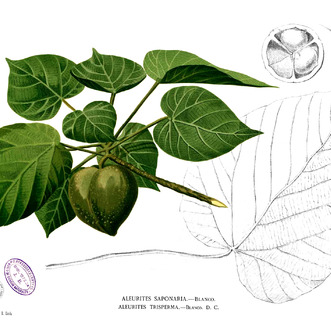Trees to 15 m tall; trunk to 35 cm d.b.h. Petiole 14-15 cm; leaf blade ovate or ovate-cordate, 12-14 × 12-13 cm, abaxial surface with hair-tufts in many vein-axils, base usually deeply cordate with rounded lobes, sometimes rounded or obtuse on old trees, apex gland-tipped. Plants dioecious, sometimes monoecious. Male inflorescences flat-topped, with many cymelets. Male flowers: calyx cylindric, ca. 13 mm, 2-or 3-lobed, glabrous; petals 5, yellowish white, obovate, obovate-spatulate, or obovate-lanceolate, 8-16 × 3-5 mm; stamens 10-13, in 2 series; outer filaments free, inner ones connate at base. Female inflorescences flat-topped, racemose, or thyrsoid. Female flowers: ovary 3-celled, ovoid-globose-trigonous, densely appressed hairy; styles bifid. Capsule depressed globose to obtusely trigonous; pericarp 4-5 × 5-6.5 cm, longitudinally 3-angular, rugose, densely velutinous-pubescent. Fl. Apr, fr. Oct.
More
A tree. It grows 15 m tall. The trunk is 35 cm across. The leaves are oval or heart shaped and 12-14 cm long by 12-13 cm wide. There are hairs on the veins underneath. Plants are separately male and female. The fruit is a flattened capsules 4-5 cm long by 5-7 cm wide. It has 3 sides.


